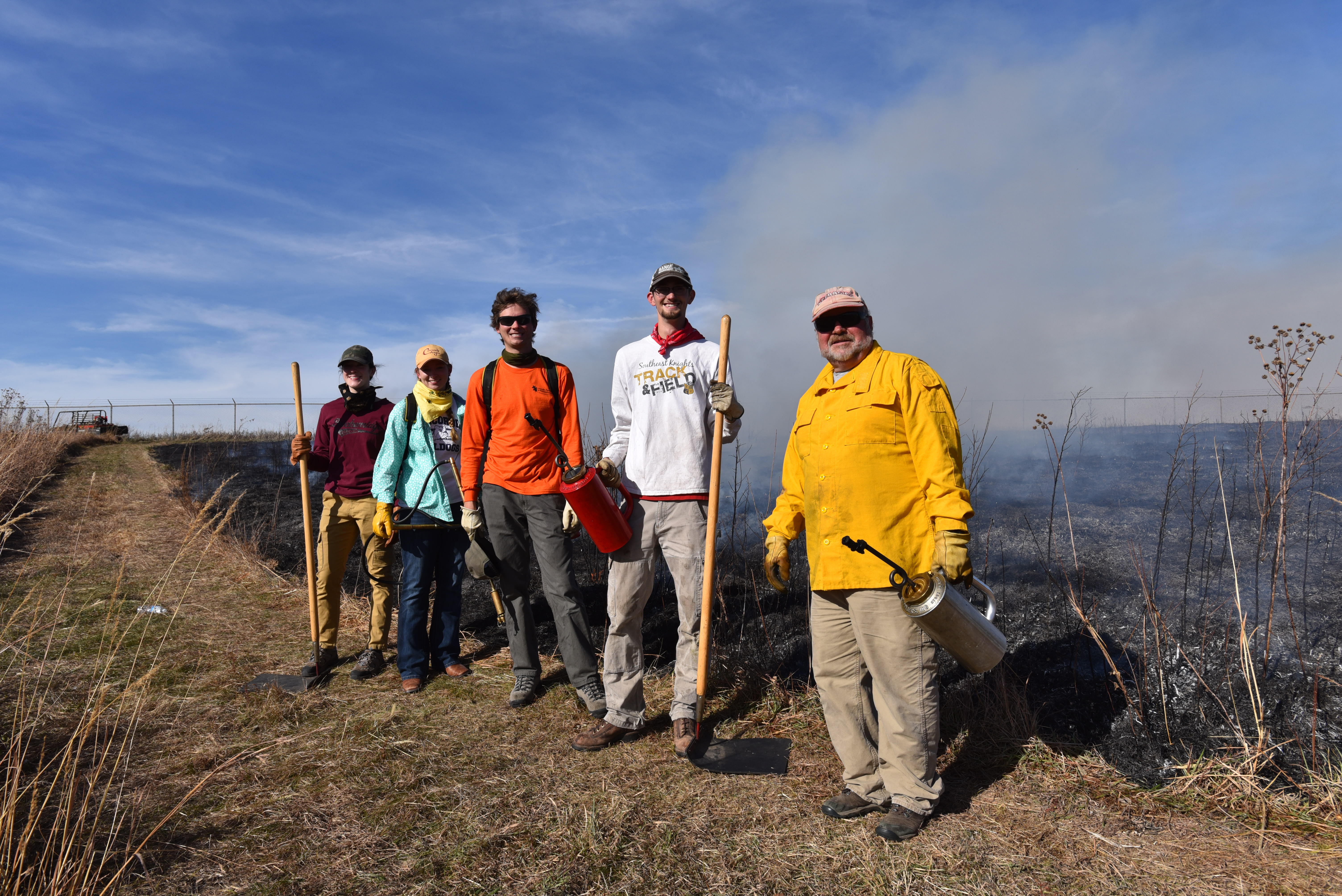
When it was done, silence filled Nine-Mile Prairie, where acres of prairie grass had just been burned to the ground in a conservation effort to foster native prairie growth and vitality.
But during the height of the fire at the property just west of Lincoln in mid-November, six pairs of hands — three undergraduate students, one graduate student, one professor, and one volunteer — used what tools were available to control, subside or direct the flames, learning on the fly just how unpredictable even controlled fire can be. In just under two hours, four acres of tall-grass prairie was gone, the landscaped blackened by smoldering ash.
“If you come back out here after a rain and the ash washes down, you’ll find all sorts of things,” said Dave Wedin, ecosystem ecologist with the School of Natural Resources, who led the burn. In the past, he told the students, he’d found little animal bones, children’s magnifying glasses, water bottles — even a camera, the body melted but memory card still intact.
The students, from the University of Nebraska-Lincoln and Concordia University, volunteered for the burn on 24-hours’ notice — the nature of prescribed fire that has to be conducted under precise weather conditions for safety. Typically done in either the fall or spring when grasses are dry, weather requirements mean sometimes burns are delayed days, weeks or months until conditions are “right” again. On Nov. 9, the conditions started out just right, with wind, temperature and humidity hitting the expected marks.
At 11 a.m., the students, dressed in long sleeves and pants, with bandanas at their necks, gathered at the 230-acre tallgrass prairie where nearly 400 plant species grow and hundreds of birds, wildlife and insect species live. As part of the prairie’s management, units are burned every three years on a rotating basis to prevent tree, brush and weed growth; knock back invasive grass species; and improve habitat. As well as larger burns, Wedin leads about a dozen small burns (2-acres or less) per year to introduce students to prescribed fire.
Within 30 minutes of arriving that Saturday, the students had been given their demonstration burn crash course: prairie burning methods used; where to burn and why; how to create a wet line perimeter; and how to burn a barrier that helps prevent fire from spreading from its intended place, and then they were taught how to use drip torches to light the fields and backpack water tanks and “flappers” to extinguish pop-up flames at the perimeters of the burn patch.
Then without much fanfare, Ethan Freese, applied science graduate student, and Nick Hoeven, senior fisheries and wildlife student — walking in opposite directions — lit the first field. The flames crackled and burned, consuming the small undergrowth and eventually the tallgrass, which burned higher and faster. Plumes of smoke filled the air.
Repeat: Stay flexible
Shortly after lighting the field, the fire leapt the break between prairie plots, setting the next plot alight.
“I’ve led over 50 prescribed burns of different sizes in the last dozen years at Nine-Mile Prairie, but this was the first time we crossed a fire break and needed to regroup to a better line,” Wedin said.
But regroup they did, the volunteers throwing their efforts into getting ahead of the fire, creating a black line along the rest of the field. Within an hour, both fields were ash, the conservation effort completed for another three years.
For the students, it a great lesson and reminder that even the best-laid plans require that one stay flexible.
“You can’t plan everything, especially when it comes to weather and dealing with nature,” said Callie McCright, junior fisheries and wildlife, about the experience. “(I learned that) you have to remember to keep your cool.”
Opportunities to get fire training
Each spring, the university offers the Wildland Fire S-130/S-190 Certification, also known as the Redcard course, a weeklong wildland fire certification class that helps students gain skills and bolster their resumes.
“These efforts are critical as we build the capacity for natural resource professionals, rural fire districts, and landowners to manage the increasing risk of wildland fire and use prescribed fire,” Wedin said in a letter to partners.
Prescribed fire is used for land management, prairie restoration, and habitat conservation, and so is useful to a diverse range of UNL majors.
Included in the Redcard training is an overview of the National Incident Management System, which coordinates the efforts of federal, state, and local agencies in all types of emergency response, including the Nebraska floods of 2019.
“Our CASNR students do not always realize that natural resource professionals, by default, often become first responders when fires, floods, blizzards and other natural disasters strike,” Wedin said. “Emergency response training, although not required in the Natural Resources curriculum, is useful and important for our graduates.”
The 2020 course is scheduled for May 11 to 15; more details will be available here in the spring.
See the burn
Curious what the prairie burn looked like from start to finish? View our Facebook photo album from the prescribed fire.
Shawna Richter-Ryerson, Natural Resources